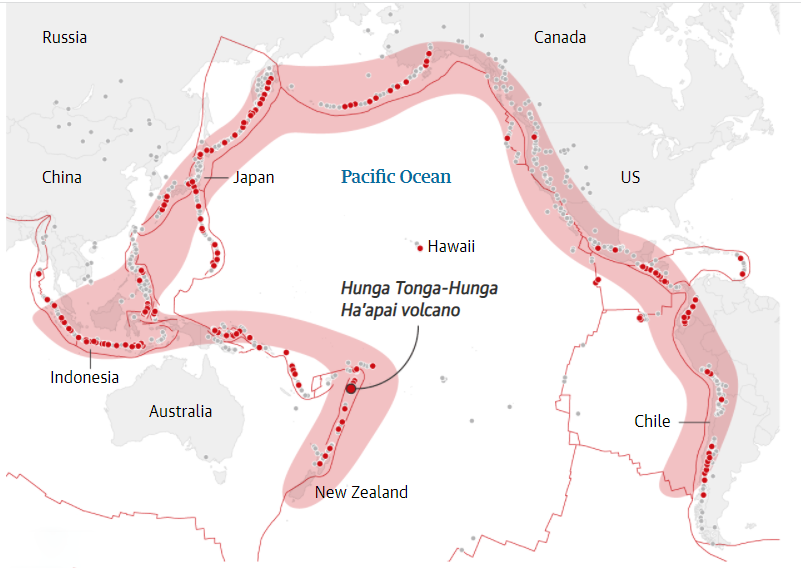Geography
Hunga Tonga-Hunga Ha'apai Volcano
- 21 Sep 2023
- 6 min read
For Prelims: Hunga Tonga-Hunga Ha'apai , Pinatubo , Krakatoa, Tambora, Samalas,Greenhouse Gases , El - Nino , Paris Agreement , IPCC, Cooling credits ,Sun dimming.
For Mains: Effect Of Volcano On Global Warming , Types of volcano
Why in News?
The Year 2023 has recorded unprecedented temperatures. Scientists believe one of the reasons for this may be an underwater volcanic eruption of Hunga Tonga-Hunga Ha'apai in the South Pacific in 2022.
What are the Key Points About Hunga Tonga-Hunga Ha'apai Volcano ?
- The Hunga Tonga-Hunga Ha’apai volcano is in the western South Pacific Ocean, west of the main inhabited islands in the Kingdom of Tonga.
- It is one of 12 confirmed submarine volcanoes along the Tofua Arc, a segment of the larger Tonga-Kermadec volcanic arc.
- The Tonga-Kermadec arc formed as a result of subduction of the Pacific Plate beneath the Indo-Australian Plate.
- It is an undersea Volcano consisting of two small uninhabited islands, Hunga-Ha’apai and Hunga-Tonga.
How will the Earth’s Temperature be Affected by the Hunga Tonga Volcano?
- Generally, massive volcanic eruptions usually reduce temperatures because they spit out vast amounts of sulfur dioxide, which form sulfate aerosols that can reflect sunlight back into space and cool Earth’s surface temporarily, generally referred as Sun dimming.
- However, the Tonga eruption had another effect because it occurred underwater. The eruption of Hunga Tonga-Hunga Ha'apai in 2022 produced a plume 58 km high, and produced the biggest atmospheric explosion ever recorded.
- The Hunga Tonga-Hunga Ha'apai eruption is peculiar because, in addition to causing the largest increase in stratospheric aerosol in decades, it also injected vast amounts of water vapor into the stratosphere.
- Water vapor is a natural greenhouse gas that absorbs solar radiation and traps heat in the atmosphere.
- The aerosol and water vapor impact the climate system in opposing ways, but several studies have proposed that, due to its larger and more persistent water vapor plume, the eruption could have a temporary net surface warming effect.
How have Previous Volcanic Eruptions Impacted the Climate Globally?
- In the past 2,500 years, there have been about eight even bigger eruptions, according to the Intergovernmental Panel on Climate Change (IPCC),
- Among them, Tambora in Indonesia in 1815 led to a "year without a summer" - with failed harvests from France to the United States.
- Even worse, the eruption of Samalas in Indonesia around 1257 led to famines and may have kicked off the Little Ice Age, an unusually cool period that lasted until the 19th century.
What are the Types of Volcanoes ?
- In general, Volcanoes can be divided on the basis of Type of Eruption & Periodicity of Eruption.
- Based on Type of Eruption: The nature of the eruption mainly depends on the viscosity of the magma and are of two types:
- Basic: The basic magma are dark coloured like basalt, rich in iron and magnesium but poor in silica. They travel far and generate broad shield volcanoes.
- Acidic: These are light-coloured, of low density, and have a high percentage of silica and therefore it makes a familiar cone volcano shape.
- Based on frequency of Eruption:
- Active volcanoes: They erupt frequently and are mostly located around the Ring of Fire.
- E.g.: Mount Stromboli is an active volcano and it produces so many gas clouds that it is called the Lighthouse of the Mediterranean.
- Dormant Volcano: These are not extinct but have not erupted in recent history. The dormant volcanoes may erupt in future.
- E.g: Mount Kilimanjaro, located in Tanzania, also the highest mountain in Africa, is known to be a dormant Volcano.
- Extinct or inactive volcanoes have not worked in the distant geological past.
- In most cases the crater of the Volcano is filled with water making it a lake. E.g.: Deccan Traps, India.
- Active volcanoes: They erupt frequently and are mostly located around the Ring of Fire.
- Based on Type of Eruption: The nature of the eruption mainly depends on the viscosity of the magma and are of two types:
Conclusion
- Any number of phenomena can sway global temperatures, from El Niño conditions in the Pacific Ocean to wildfires in Siberia.
- The Hunga Tonga-Hunga Ha'apai eruption may nudge the temperature past 1.5°C of warming, but that doesn’t mean the Paris Agreement has failed yet; the event demonstrated how close the world is to its agreed-upon tipping point.
UPSC Civil Services Examination, Previous Year Question (PYQ)
Q. Mention the global occurrence of volcanic eruptions in 2021 and their impact on regional environment. (2021)







